Last Wednesday, after diving Wheeler, Lynch and Chicken reefs we made it to Davies. I particularly wanted to visit this reef as the Australian Institute of Science (AIMS) has a weather station here at Davies.
Stuart put his drone up and got photographs of the weather station and its immediate surrounds.

There is no evidence of recent bleaching from this aerial photograph, but rather patches of reef that appear to have been lost to brown algae. It looks devastating from the air, the extent of the infestation of algae.
AIMS records temperatures at different depth at some reefs with the temperature data for Davies at a depth of 4 metres extending back to 1991, providing 33 years of information on water temperatures. The warmest summer in this record is in the year 2020.
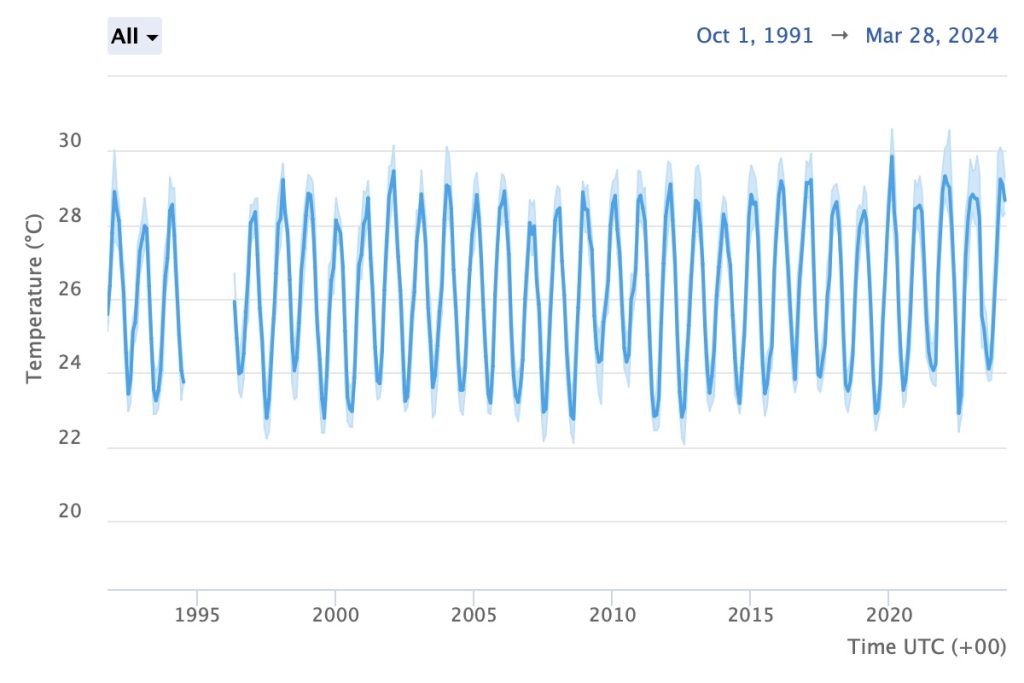
AIMS also collects water temperature data down to 18.5 metres at Davies. This data also shows temperatures cycling within an approximate 6C range. This data does not suggest that this summer has been particularly warm – at least not in this central region relative to the last 18 summers, which is the extent of the publicly available temperature record at this depth for Davies reef.
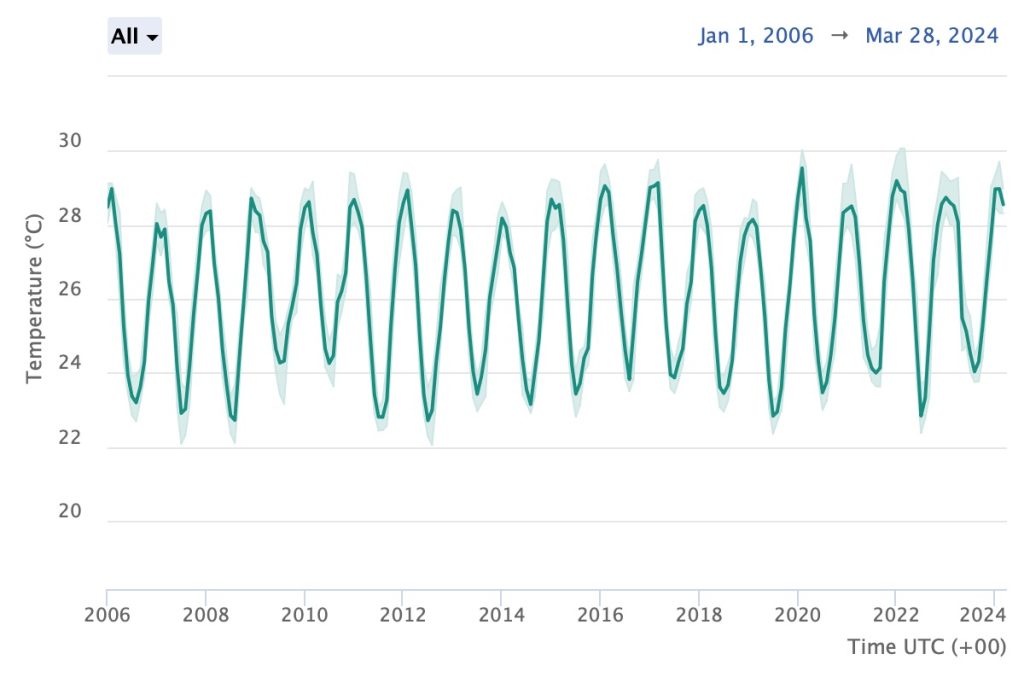
This summer at Davies, temperatures don’t appear to have got unusually warm – with the time series data from both 4 metres and 18.5 metres extending right up to 28th March 2024; right up until the end of summer and some.
Yet the reef crest, at Davies, as for Lynch, was looking devastatingly bare.
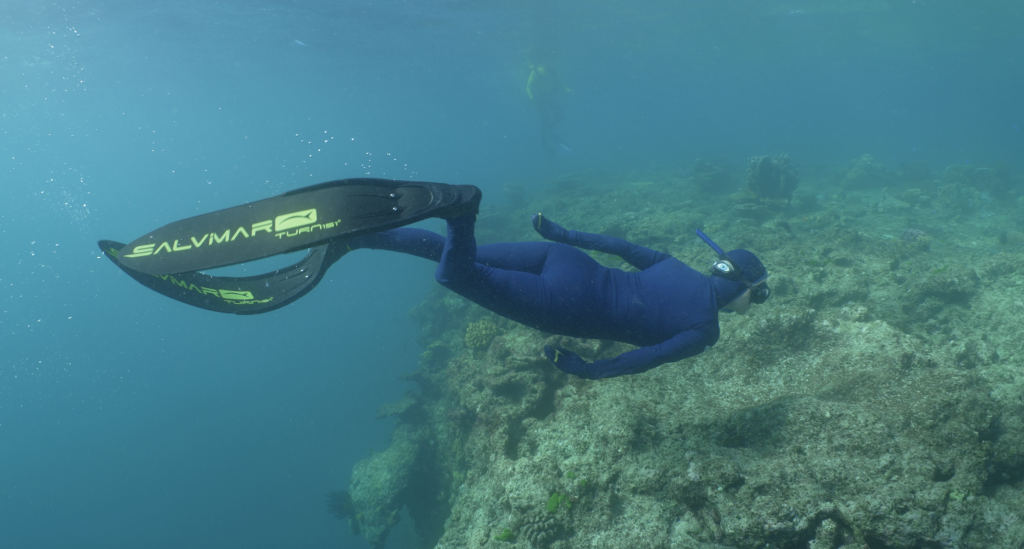
Tropical cyclone Kirrily hit on 25th January; nearly 10 weeks ago. It has scoured the shallow flat top of this reef, and it seems also the wall.
As there is no coral, presumably following pummelling by the cyclone, specifically TC Kirrily, well, there is nothing to bleach.
At some depth it is the well attached corals that have survived and show some bleaching.
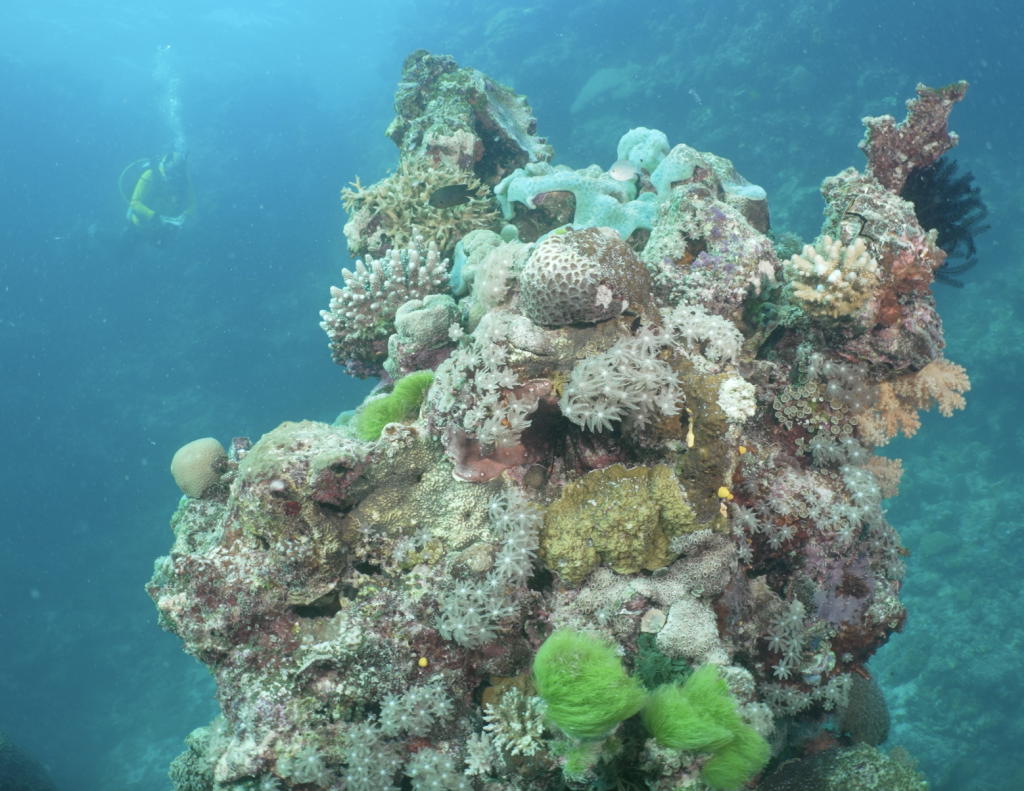
Amazingly, we did find some large healthy plate corals at a different section of the reef crest that have survived, and they are a good dark brown meaning they are replete with zooxanthellae.
This clip that Stuart filmed shows these large brown plates at the crest of Davies, on Wednesday 3rd April 2024.
How did these large plates manage to avoid being smashed into chunks, and then swept over the edge by TC Kirrily?
Perhaps because there is not much coral left, the extent of damage from coralliferous fishes, perhaps bump head parrot fish, seems severe.

We only had time to dive the northwest of this reef, with less than an hour in the water.
Hopefully there are other sections with more coral – hopefully there are other sections less affected by TC Kirrily.
As I posted at my Facebook page earlier today: there are two types of scientists, those who try and make their observations fit the narrative and those who let the data speak for itself. I am a fan of the latter; I seek information about the natural environment not to confirm my prejudices, but to learn about nature.
We can’t know whether this section of the Great Barrier Reef is suffering from global warming or cyclone damage, if we aren’t prepared to get into the water and make some observations.
I am a huge fan of 19th century British biologist Thomas Huxley. Back in 1860 he wrote:
My business is to teach my aspirations to conform themselves to fact, not to try and make facts harmonise with my aspirations. Science seems to me to teach in the highest and strongest manner the great truth which is embodied in the Christian concept of entire surrender to the will of God. Sit down before each fact as a little child, be prepared to give up every preconceived notion, follow humbly wherever and to whatever abysses nature leads, or you shall learn nothing. I have only begun to learn content and peace of mind since I have resolved at all risks to do this.”
It is the case that the corals in the central region of the Great Barrier Reef appear to have been more impacted by TC Kirrily, than warmer than average water temperatures.
This is my observation, supported by the available water temperature data for Davies reef; the AIMS data.
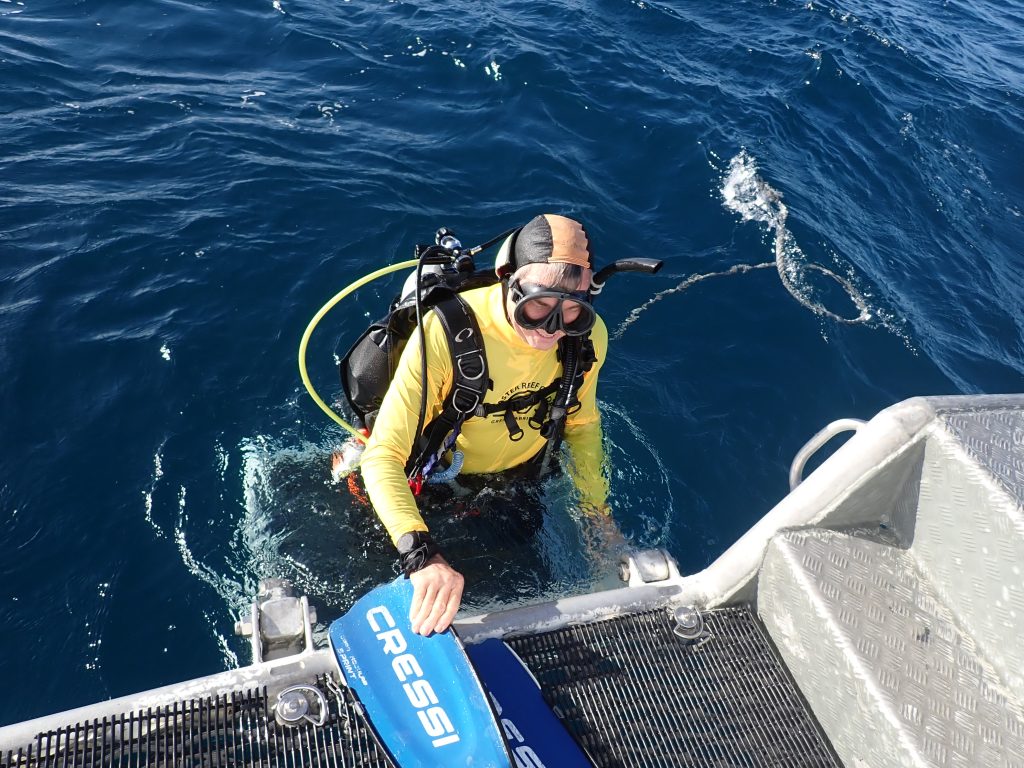
I’m very grateful to Adrenalin Dive for the opportunity to visit this reef, and to the Institute of Public Affairs for funding this adventure. The video and photographs are by Stuart Ireland. Stuart has passed me the raw footage, that I have posted clips and snippets of here. There will be a short documentary, with much more information and interviews soon.
To stay in the loop, consider subscribing for my monthly emails with the latest news.
*****
The feature image (at the very top of this post) shows me/Jennifer Marohasy swimming while holding my breath. Following is Paul Crocombe on scuba, blowing bubbles. The photograph is a screenshot from video taken under-the-water by Stuart Ireland. (I was on snorkel/free diving all day on Wednesday.)
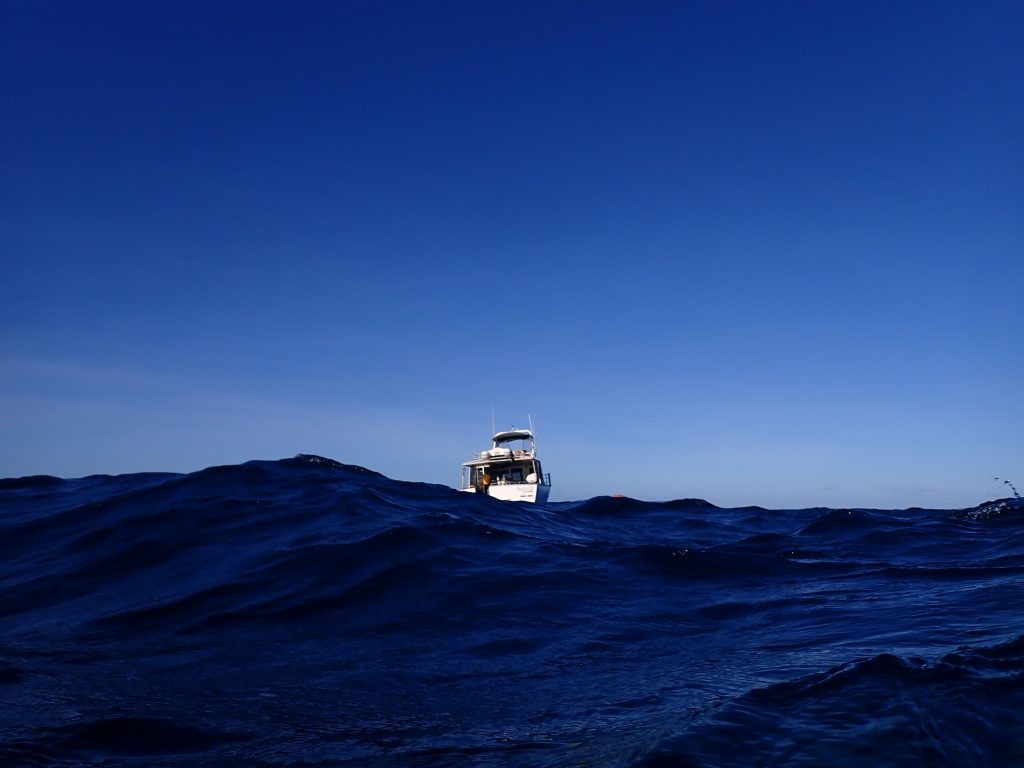
And a last photograph of the boat taken on my Olympus TG6, when I came up for air. The water really was that blue, at Davies Reef last Wednesday.

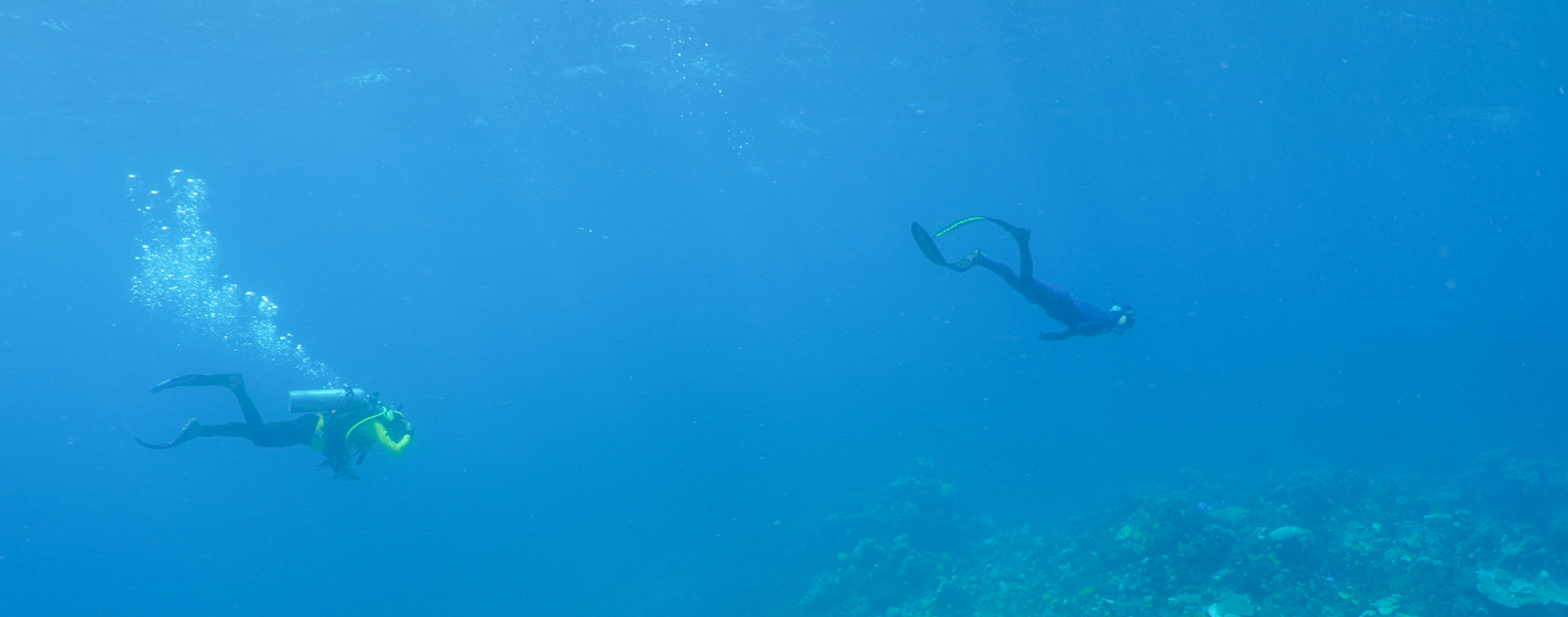
 Jennifer Marohasy BSc PhD is a critical thinker with expertise in the scientific method.
Jennifer Marohasy BSc PhD is a critical thinker with expertise in the scientific method.

Thanks again Jen for a very realistic summary. Very interesting temperature graphs.
Nothing unprecedented.
Thanks Spangled, you might like to play with the temperature data, that is here: https://apps.aims.gov.au/ts-explorer/?source=63:Weather%20station&fromDate=1991-10-18T00:00:00&thruDate=2024-04-05T00:00:00
thank you for showing us something worthwhile from the coalface.
Hi Jennifer. I think there is a typo in the fourth paragraph of your story above describing the warmest summer as 2000. The graph shows that it should read 2020.
Regards
John Nethery
*****
Thanks for spotting that. :-). Just now fixed. Jen
Thanks Jennifer
Great work and thanks for sharing your experience and information.
Would be great if your information and Videos could be followed in Schools…
Gayl 😊
Did you dive areas affected by the tidal currents-algae growth indicates stagnant water ie no tidal currents-I’ve always found healthiest coral in areas of good tidal flow and tops very vulnerable to wave action damage and stagnant water which can heat up in one spot but then when it moves cause a trail of destruction-really noticeable if you swim into such a pool of heated water that has moved off the reef
Algae growth suggests stagnant water-stagnant water means no tidal movement means insufficient food supply-I suspect area of good coral was where there was tidal run was sufficient to maintain growth?
I’m surprised at your claim that the Davies Reef data does not show global warming. I looked at the average temperature of hottest week for the 31 years of data. There is clearly a warming trend.
https://i.postimg.cc/PqxMjkxQ/avies-Reef-Capture.jpg
2020 was a hot year and there is no data shown after that, temperatures apart from 2020 and some other years are much the same. the red line is misleading. It only shows a warming trend if you wear rose coloured glasses.
Great work, Jennifer. As for global warming, the question is not merely whether it is happening. It is whether it would make a difference to the reef, and whether it might be caused by man-made carbon dioxide emissions. My understanding, guided partly by your work, is that it would probably enhance the growth of the reef. My understanding, guided by my own mathematical investigations, is that it cannot be caused by man-made carbon dioxide emissions. But your immediate factual data trumps all.
Les Aldridge, look more closely, I used the same dataset as Jennifer. It goes from 1991 to current dsy. No need for rose-coloured glasses it is a statistically calculated linear trend line. The equation is included.
https://i.postimg.cc/k5ZBQqwG/Capture45747.jpg
Thank you so much, Jennifer, for being one of those rare “straight-shooters” we can trust – minus spin!
These reefs-looking at my navionics app are all in area influenced by diurnal tidal runs-research needs to be done on history of flooding tidal runs ie from the east versus equalizing flow from north northwest-Hammond rock tidal stream predictions as published by BOM for Torres straits show differences to the norm as I remember-when equalizing tide is predominant which has been the case it backs up on the flooding tidal run causing higher than normal tides and prevents cooler waters from the deeper eastern areas entering this diurnal area-this prevents large dumps of flood freshwater from getting away and stops cooler nutrient rich water from the deeper east from making its way into the inner reef system-after the equinox these tidal streams become more equal and even favour a easterly flow-I tend to think it’s a planetary thing something to do with earths tilt and proximity to Sun and moon and have tried to get records from BOM-apparently they do tidal predictions from planetary models for every day of the year and calculate accordingly-in all the years of diving for lobster tidal stream predictions had been extremely accurate so much so that it became our dive bible-lack of water flow also causes algae growth that Jennifer mentioned she saw-I’m not a scientist and am open to any opinion-I’m on a lobster resource assessment group in the Torres Strait and believe that recruitment of juveniles is dependent on the interaction of diurnal currents with the coral sea gyro and have put a lot of thought into this but lack the scientific expertise -my phone number is 0427558332
Interesting as always Jen. Let the facts speak for themselves. Thankyou for your passion for truth in science, and your endeavours to share these facts with those who seek the truth.
“March 2024 was warmer globally than any previous March in the data record, with an average ERA5 surface air temperature of 14.14°C, 0.73°C above the 1991-2020 average for March and 0.10°C above the previous high set in March 2016. This is the tenth month in a row that is the warmest on record for the respective month of the year. The month was 1.68°C warmer than an estimate of the March average for 1850-1900, the designated pre-industrial reference period. The global-average temperature for the past twelve months (April 2023 – March 2024) is the highest on record, at 0.70°C above the 1991-2020 average and 1.58°C above the 1850-1900 pre-industrial average.
The average European temperature for March 2024 was 2.12°C above the 1991-2020 average for March, making the month the second warmest March on record for the continent, only a marginal 0.02°C cooler than March 2014. Temperatures were most above average in central and eastern regions. Outside Europe, temperatures were most above average over eastern North America, Greenland, eastern Russia, Central America, parts of South America, many parts of Africa, southern Australia and parts of Antarctica. The El Niño continued to weaken in the eastern equatorial Pacific, but marine air temperatures in general remained at an unusually high level. The global sea surface temperature averaged for March over 60°S–60°N was 21.07°C, the highest monthly value on record, marginally above the 21.06°C recorded for February.” – Copernicus Climate Change Service. https://climate.copernicus.eu/surface-air-temperature-march-2024
“Global warming is actually not a hard issue to dissect, because fundamentally it relies on evidence of there being a general trend of temperature increase – and measuring temperatures is not rocket science. Of course, there is nowhere on Earth where the mean global temperature anomaly can be measured. So, steer-clear when this statistic is mentioned by an expert – you can probably dismiss it as something entirely contrived, like say the Virgin birth.” – J. Marohasy Feb, 2018. http://www.onlineopinion.com.au/view.asp?article=19580
Thanks Kevin. It is the case that you can not measure the average temperature of the Earth as such, and that how it is currently being constructed but the Copernicus group that you quote from above has everything to do with politics and very little to do with science, I explain more in the following link:
And in the same article I propose a solution: https://jennifermarohasy.com/2023/07/hot-as-ice-in-the-antarctic-global-temperatures-this-june/
And to quote from the above:
“A solution is to perhaps do away with the random selection of weather stations and to focus instead on a simple index based on a good sample of well-sited weather stations with long histories, like Mawson.
Such a concept could be based on the Dow Jones Averages or the S&P 500. No one ever tries establishing an impossible-to-define ‘average stock price’ — including many stocks of doubtful provenance — and nobody cares.
Rather the solution is to perhaps have a pre-selected index of certain representative weather stations, that are then followed over a long-time span and with temperatures reliably measured, which will require some modification to current methods and of course, no subsequent adjusting.” Ends.
In the case of the Great Barrier Reef it would be good to focus in on a few long and reliable temperature series, and for us to be updated on what they show regularly.
I have attempted to extend to show, something of how we might extent the water temperature data for the reef backs some here, https://jennifermarohasy.com/2019/08/lady-elliot-just-a-hot-flush/
Lady Elliot Island is interesting. Extrapolating your trend line that ends in 2018, it looks like annual maximum temperatures in 2023 might be about 26.5 degrees. It was about 27 degrees.
Over the last 12 months it was 1.2 degrees above the climate average for the island. Only one month was cooler. Infact, three months (Feb, Jul & Aug) were over 1.9 degrees warmer than the monthly average.
Thank you Jenifer, always enjoy your writing, I think one of the biggest problems, especially for the western nations, is GLOBAL BS. The completely irrational reaction to COVID, being a pretty good example, in my opinion. As far as global warming, which morphed into climate change, for me the homogenisation of temperature records, is all I need to know. I wish your work, also Peter Ridd, would be given more prominence in media. Cheers Michael Tarbuck
Hi Jennifer, thanks for your writing, so good to read something based on scientific facts, and actual observation. For myself, I’m more concerned about GLOBAL BS, than global warming/climate change. Cheers Michael Tarbuck